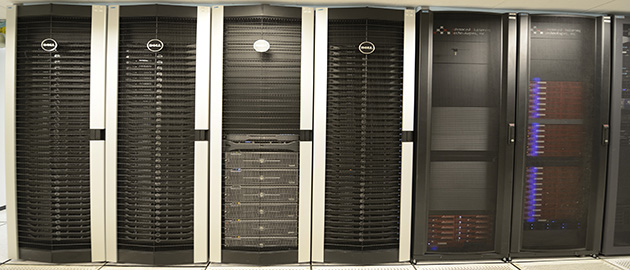
High Performance Computing Facility
High-performance computing (HPC) refers to the use of supercomputers and/or computer clusters to accelerate the solution of fundamental problems in science, engineering
SIHPSI is expected to expand the scope and quality of research at SIUC in two broad areas: (1)Computational nanoscience and engineering (CNE): Projects include quantum simulations of nanoscale devices with tens of millions of complex degrees of freedom; computational design of catalysts at the molecular level; large scale computations of multiphase flows such as solidification of binary alloys, dynamics of red and white blood cells in arteries, boiling phenomena in energy generation and electronic cooling, and enhancement of heat and mass transfer by bubble columns in bioprocesses; molecular dynamics studies of polymer morphology at interfaces; fundamental studies of the non-equilibrium states of matter; and quantum information processing exploring new properties of atomic nuclei. (2) Geographic Information Science (GIS): Involves strategic research to investigate new algorithms for representation and transformation of massive dynamic data allowing a cognitive and visual interpretation for analysts by exploiting invariant geometric properties. New representations of the large-scale datasets have the potential to change the way people utilize the data for knowledge discovery.
Computational research in the nanoscience area will support experimental sciences in the pursuit of scientific discovery and technical innovation and is expected to have significant impact in a wide range of technological applications including low-power and fast transistors, coatings, lithography, adhesives to light emitting diodes and sensors, various smart and functionalized materials, and quantum computation. While the GIS research will facilitate efficient data streaming, crime and health studies, medical imaging, and genome mapping.
Earlier in 2009, SIHPSI principal investigator Shaikh Ahmed, an Associate Professor in the Department of Electrical and Computer Engineering in the College of Engineering, was one of four researchers nationwide included in Oak Ridge National Laboratory's first High-Performance Computing Grants Competition that allowed his research group access to ORNL's Jaguar supercomputer and other top-end computing platforms and staff housed at the site in Tennessee. Ahmed's group uses the massive computing power to conduct research in petascale modeling and designing of nanoscale devices for use in
Visit the High-Performance Computing website for more information.
